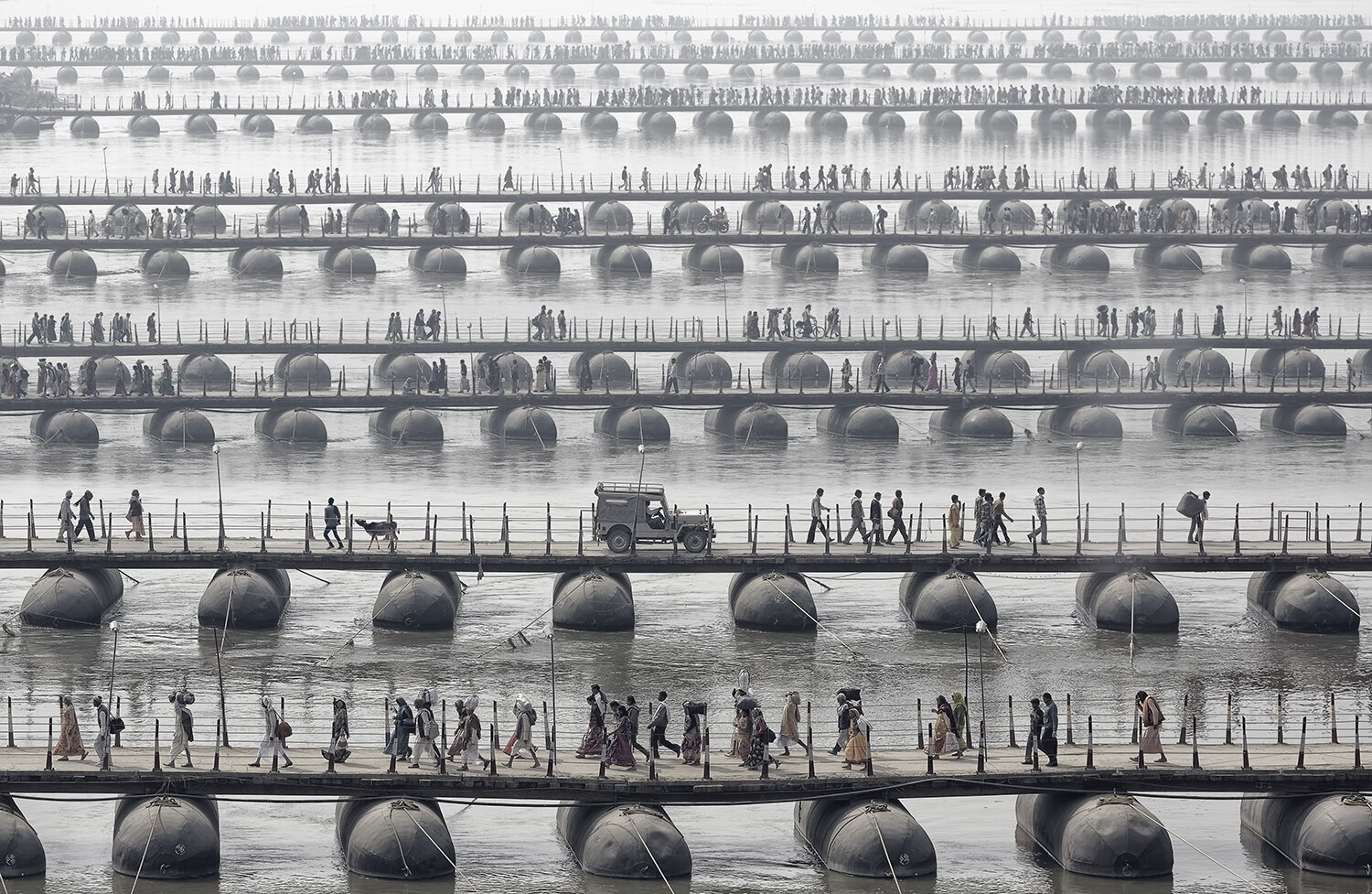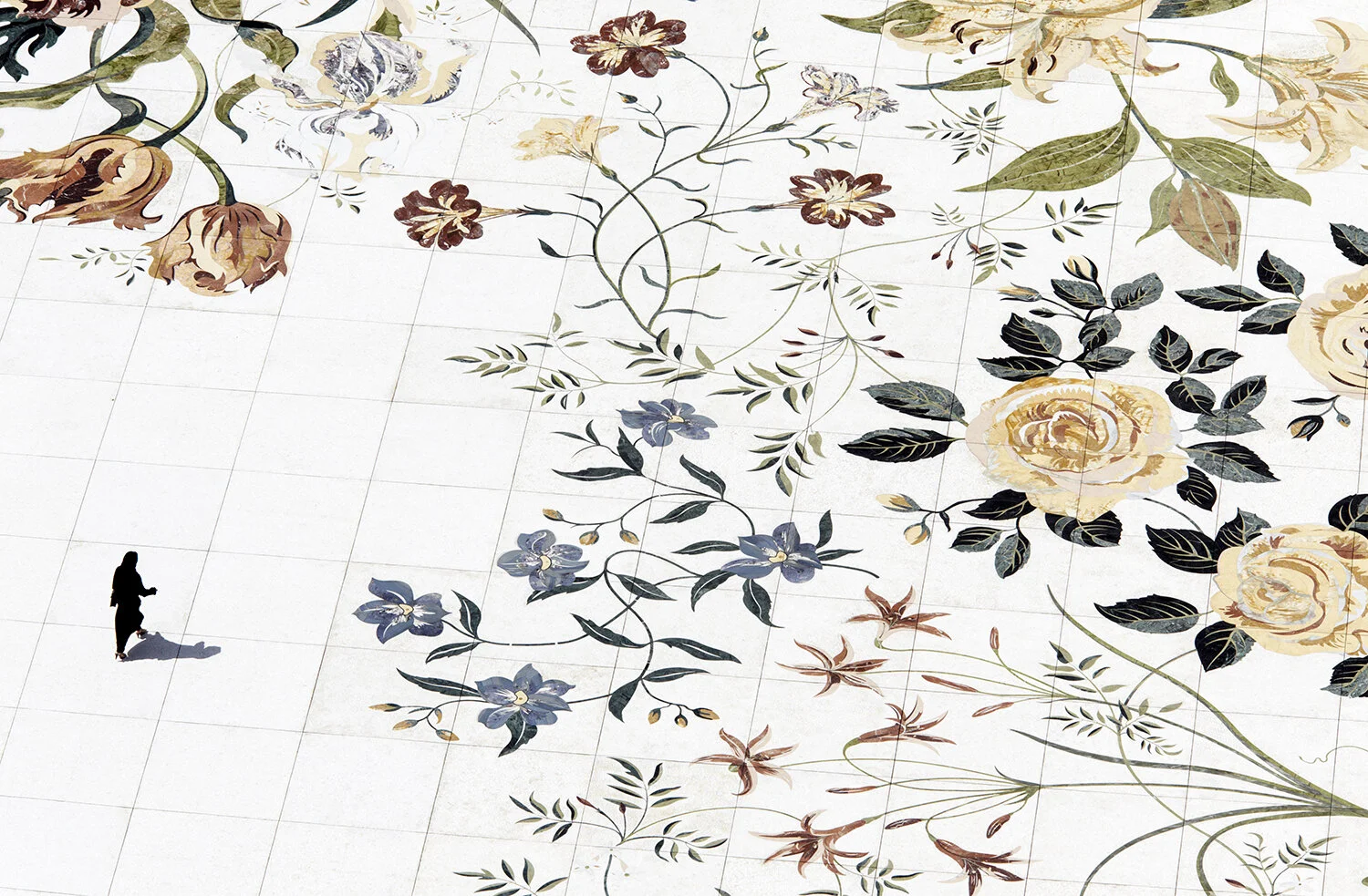Medium / Rare - essay
Medium / Rare
Rarely Seen: Photographs of the Extraordinary
Aotea Utanganui Museum of South Taranaki
Pātea
March 1 – August 31, 2019
by Emil McAvoy
Wolfgang Weinhardt, Pontoon Bridges, India, National Geographic
National Geographic magazine has exerted a significant influence on the public imagination for over 130 years – primarily, of course, through the medium of photography. Published continuously since the first edition in 1888, its glossy, dramatic photography and distinctive yellow-bordered cover have become iconic. Despite the magazine's legacy, there are aspects of the wider non-profit National Geographic Society's activities which are, perhaps, lesser known or more rarely seen.
I recently opened the July 2019 issue I found on the table at a friend's house which detailed the history of space travel – and plans for the new era of space exploration – in the context of the 50th anniversary of the "first man on the moon". Given the sheer volume of material available on the subject, I was struck by how concise, authoritative, accessible and visually engaging its presentation was. I photographed the cover with my phone camera as a note-to-self to purchase a copy. I see they have also made much of this material available online.
Lukas Gawenda, Where the Buffalo Roam, Yellowstone National Park Wyoming, National Geographic
National Geographic is communicative: high end 'edutainment' if you will. Photography became its trademark by 1910, following an emphasis on visual illustration and communication first promoted by, among others, Society President and inventor Alexander Graham Bell.
The magazine's influence was perhaps most keenly felt in the pre-digital era, where the circulation of printed images (notably in vivid colour from the early 1930s when this technology was emerging) played an important role in informing and inspiring readers on facets of life elsewhere around the globe. According to The Washington Post, as of 2015, National Geographic is circulated worldwide in nearly 40 local-language editions and has a global circulation of approximately 6.5 million per month (down from about 12 million in the late 1980's).
In Aotearoa New Zealand, this influence was surely amplified by its geographical isolation. Growing up in New Zealand in the 1980s, National Geographic opened doors in my young imagination. I recall rifling through my grandparents' copies which were studiously collected in giant stacks, or gravitating toward them in 'opportunity shops'. Old issues often made their way in to my classrooms, both for research and offered up as raw material for fledgling experiments with photomontage.
Joel Sartore, Hey that tickles, Nebraska, National Geographic
National Geographic's reach now spans a TV channel, podcasts, live events, participatory communities for independent photographers, educational initiatives, philanthropy and travelling exhibitions. Aotea Utanganui Museum of South Taranaki in Pātea recently hosted one such exhibition, Rarely Seen: Photographs of the Extraordinary, which featured 50 prints from National Geographic. It was the result of a year's negotiation between the two parties, and is the only New Zealand venue (to date) to exhibit the show.
Kathryn Keane, Vice President for National Geographic Exhibitions, asserts in their media release: “Rarely Seen is a great example of National Geographic’s rich history of sharing places, moments and objects that astonish and inspire”. Cameron S. Curd, Kaitiaki Pukapuka-a-Rohe/District Archivist for Aotea Utanganui, also notes: “This collection from the stables of the world’s leading geography imaging organisation is truly unseen in many ways".
Vicki Mar, Moeraki Boulders, New Zealand, National Geographic
So what is "unseen" – or "rarely seen" – in this collection of images? That may depend on one's vantage point. A photograph of a Moeraki Boulder from Koekohe Beach on the Otago coast may be familiar to local audiences, while a distant shore to others. Whether it is a remote region, an animal in the wild, or a microscopic image of a snowflake, a key to the show is that viewers gain access to unique sights (and sites) they might not otherwise witness in person.
Kenneth Libbrecht, Snowflake, Vermont, National Geographic
The introductory wall text written by American photojournalist and National Geographic photographer Stephen Alvarez asserts:
Since the invention of the camera, this has been the photographer’s role: To make the unknown known. In the late 1800s, photographers making geographic surveys of the American West brought its wonders back to a gob-smacked audience. The images offered proof that landscapes beyond the imagination were real. Photographs of the Grand Canyon from John Wesley Powell’s Colorado River expeditions defined the American West as a place of vast potential. William Henry Jackson captured Yellowstone’s fantastic array of geysers for the first time. His pictures helped establish the first national park. Photographers fuel exploration and preservation. It is a role we have embraced with open arms at National Geographic.
Dave Yoder, Walk with the flowers, Abu Dhabi, National Geographic
As one might expect from an exhibition designed to tour internationally, the images presented here are highly accessible. There is also a somewhat idealising quality to many of these photographs, particularly those which celebrate the natural world. Given the urgency of accelerating environmental degradation and a rapidly changing climate – alongside a cultural climate in which personal or collective denial of these realities are untennable – this is also accompanied by a sense that sights like these may be increasingly rare. Hence, some of these images could be seen to function like specimens in a zoo: captured and (perhaps problematically) exhibited in the hope of preserving their subjects. While Alvarez points to photography's "fuel for exploration and preservation", we must also acknowledge its corresponding historical role in colonisation and exploitation. Capturing a subject may have complex implications for it far beyond the photographer's imagination. What if photographs in the future become like the taxidermied animals we see here – dusted by a museum worker in Nebraska – the only a remnant of a world we effectively destroyed?
Tomas Munita, Green Piano, Japan, National Geographic
One photograph in Rarely Seen features an abandoned piano in Fukushima overgrown with foliage as radioactive vegetation reclaims the region. Perhaps these images may be destined to become records of disappearance; yet if the natural world is lost it would appear so are we – along with our images of both nature and ourselves.
The tone of National Geographic's environmental advocacy, on the other hand, is always carefully measured, as it plays the 'neutral' scientist while in part attempting to save the planet. In this respect, accompanying images are essential to convincing audiences of these alarming realities which until recently may have been rarely seen, yet are increasingly visible.
Marko Korosec, Supercell Storm Cloud, Julesburg Colorado, National Geographic
In this exhibition, the medium of photography helps us in part to better imagine and understand the lives of others, including diverse cultures, animals and ecologies. In this context, it is also interesting to see this American publication recently re-examine its own racist past, prompted by a world now forced to reconsider who or what is exoticised, by whom, and for what purpose.
In our increasingly mediated cultures, perhaps potential solutions to the pressing issues we collectively face also lie in personal connections fostered through photographic transmission: that as audiences we may better understand other cultures and ecologies – and their inherent sacredness – through the poetics and politics of image exchange. In this age of extraordinary ecological, economic and political precariousness, exploring and celebrating biodiversity – and our shared cultural heritage – needs more than ever to be consciously connected to preserving and protecting them.
Emil McAvoy is an artist, art writer and lecturer in Photo Media at Whitecliffe College of Arts and Design
This essay was commissioned by Aotea Utanganui Museum of South Taranaki and images are used with permission.








